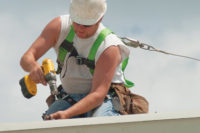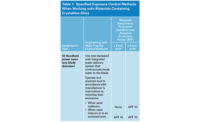Out of 4,674 worker fatalities in private industry in calendar year 2017, 971, or 20.7 percent, were in construction. One in five worker fatalities in 2017 were in construction. The leading causes of death (excluding highway collisions) in the construction industry were falls, followed by struck-by object, electrocution, and caught-in/between. Falls made up 381 out of 971 total fatalities in construction in which was 39.2 percent.
When employees are performing construction work six feet or more above a lower level, you need to provide them with some type of fall protection. There is an exception for working on scaffolding — the threshold height for fall protection is ten feet. OSHA regulates falls at 1926 Subpart M.
The three most common fall protection systems are:
- Guardrail;
- Safety net; or
- Personal fall arrest.
Guardrails are a good option because if they are installed properly they prevent employees from falling. They’re almost always the preferred method of providing fall protection.
Safety net systems are designed to catch employees after they have fallen. Installation of safety nets can be expensive and labor intensive, and if an employee does fall into a net you must have a plan to rescue them.
A personal fall arrest system works after a fall and won’t prevent the fall. The components of the system are the anchorage, lanyard, connectors, and full-body harness.
There are five common areas on construction sites that employees fall from:
1- Unprotected leading edges
Unprotected leading edges are common jobsite hazards. A guardrail system is the best way to protect employees.
There may be times when a guardrail can’t be installed because work is being done right at the edge. If that is the case, then a safety net or a personal fall arrest system must be used.
The fall protection training requirements at 1926.503 apply to working at or near unprotected leading edges. The employer must also certify the training and provide retraining as necessary.
Use the training to reinforce the dangers of falls and your commitment to protecting employees.
2- Scaffolds
Scaffolds can also pose fall hazards, for example, when the guardrail isn’t constructed properly, or scaffold platforms are accessed by climbing the cross-braces. OSHA has very specific requirements for fall protection depending on the type of scaffold and how it is used.
There are also requirements that scaffold platforms be fully planked and allow for overlapping of planks in certain circumstances. OSHA says that platforms be erected no more than 14 inches from the face of the work, unless guardrails are provided, or personal fall arrest systems are used.
Training outlined in 1926.454 applies to scaffold users and requires training by a qualified person in the:
- Nature of electrical hazards, fall hazards and falling object hazards in the work area;
- Procedures for dealing with electrical hazards and for erecting, maintaining, and disassembling fall protection systems and falling object protection systems being used;
- Proper use of the scaffold, and the proper handling of materials on the scaffold;
- Maximum intended load and the load-carrying capacities of the scaffolds used; and
- Other pertinent requirements.
If your employees are erecting, disassembling, moving, operating, repairing, maintaining, or inspecting a scaffold they also need training from a competent person.
3- Scissor lifts
OSHA considers a scissor lift to be a mobile scaffold and regulates them at 1926.452(w).
Falls can occur from scissor lifts when employees remove the manufacturer’s guardrail, or when they climb on the guardrails to reach a higher point.
A personal fall arrest system is not required for workers in a scissor lift, although some employers have rules that stipulate occupants of any types of lift must wear a harness and use a lanyard to tie-off.
All the training requirements in 1926.454 apply to users of scaffolding.
4- Aerial lifts
OSHA regulates aerial lifts used in construction at 1926.453, which includes the requirement that employees working on aerial lifts be tied-off. This cuts down on the number of falls, but some may still happen if the employee fails to tie-off or ties-off to the wrong anchor point.
Falls can also occur when employees move from the lift to an elevated surface. OSHA doesn’t specifically prohibit workers from exiting or entering an aerial lift basket that rests on or adjacent to an elevated surface. However, when employees move from the basket to the elevated surface, the requirements in 1926 Subpart M apply.
A worker may enter or exit an aerial lift (at heights above 6 feet) provided that fall protection such as guardrails or a fall arrest system is used while the worker moves between the lift and the working surface. During entry to and egress from the lift, a worker may tie-off to the lift (if the lift is designed to withstand the vertical and lateral loads imposed by the employee's movement itself or by an arrested fall) or to an appropriate nearby structure.
All the applicable training requirements in 1926.454 apply to users of aerial lifts.
5- Ladders
OSHA regulates ladders used in construction at 1926.1053. Failing to use portable ladders correctly can result in falls.
OSHA’s ladder training requirements at 1926.1060 apply. Ensure each employee has been trained by a competent person in the following areas, as applicable:
- Nature of fall hazards in the work area;
- Proper construction, use, placement, and care in handling of all stairways and ladders;
- The maximum intended load-carrying capacities of ladders used; and
- The related OSHA standards.
Wrap-up
OSHA recognizes that incidents involving falls are generally complex events, frequently involving a variety of factors. That’s why their standards for fall protection deal with both the human and equipment-related issues.






